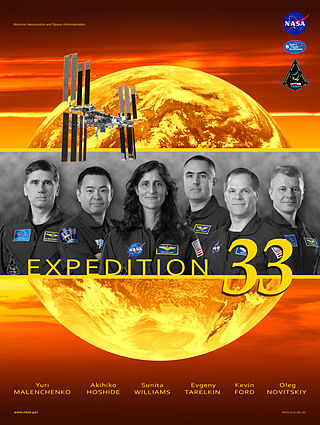Expedition 33
Long-duration mission to the International Space Station From Wikipedia, the free encyclopedia
Expedition 33 was the 33rd long-duration expedition to the International Space Station (ISS). It began on 16 September 2012 with the departure from the ISS of the Soyuz TMA-04M spacecraft, which returned the Expedition 32 crew to Earth.[1]
A request that this article title be changed to Expedition 33 (ISS) is under discussion. Please do not move this article until the discussion is closed. |
 Promotional Poster | |
| Mission type | Long-duration expedition |
|---|---|
| Expedition | |
| Space station | International Space Station |
| Began | 16 September 2012, 23:09 UTC[1] |
| Ended | 18 November 2012[1] |
| Arrived aboard | Soyuz TMA-05M Soyuz TMA-06M |
| Departed aboard | Soyuz TMA-05M Soyuz TMA-06M |
| Crew | |
| Crew size | 6 |
| Members | Expedition 32/33: Sunita Williams Yuri Malenchenko Akihiko Hoshide Expedition 33/34: Kevin A. Ford Oleg Novitskiy Evgeny Tarelkin |
 Expedition 33 mission patch  (l-r) Williams, Malenchenko, Hoshide, Tarelkin, Novitskiy and Ford | |
Crew
| Position | First Part (September–October 2012) |
Second Part (October–November 2012) |
|---|---|---|
| Commander | Second spaceflight | |
| Flight Engineer 1 | Fifth spaceflight | |
| Flight Engineer 2 | Second spaceflight | |
| Flight Engineer 3 | Second and last spaceflight | |
| Flight Engineer 4 | First spaceflight | |
| Flight Engineer 5 | Only spaceflight | |

Notable experiments
The crew successfully experimented with the Delay-tolerant networking protocol and managed to control a Lego robot on Earth from space.[5]
References
External links
Wikiwand - on
Seamless Wikipedia browsing. On steroids.
